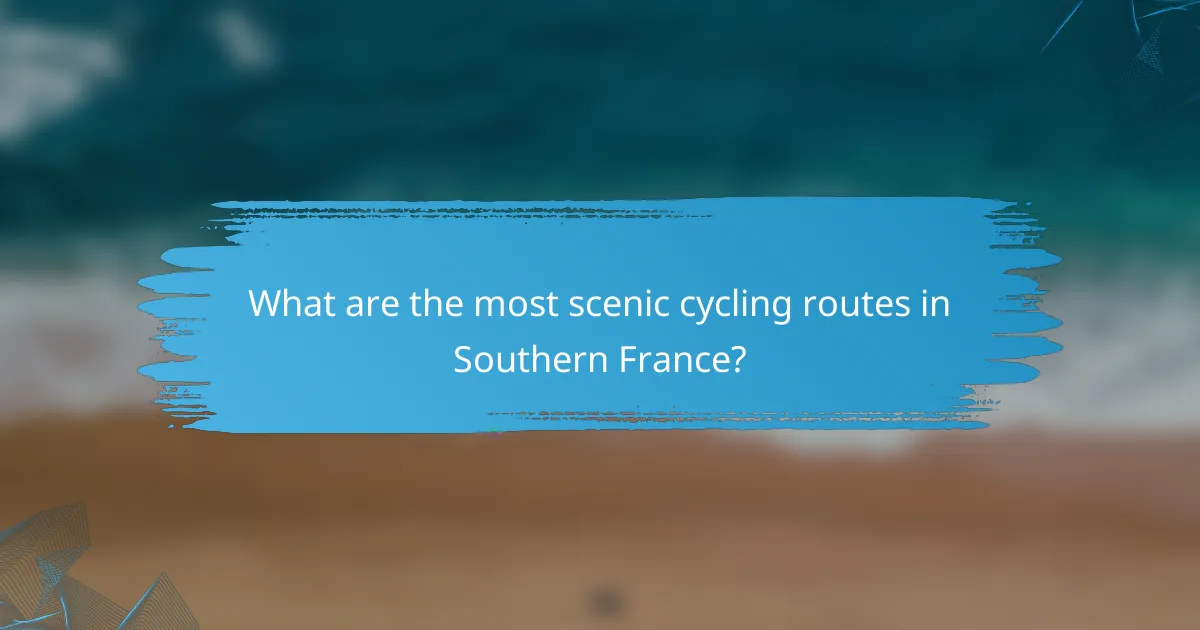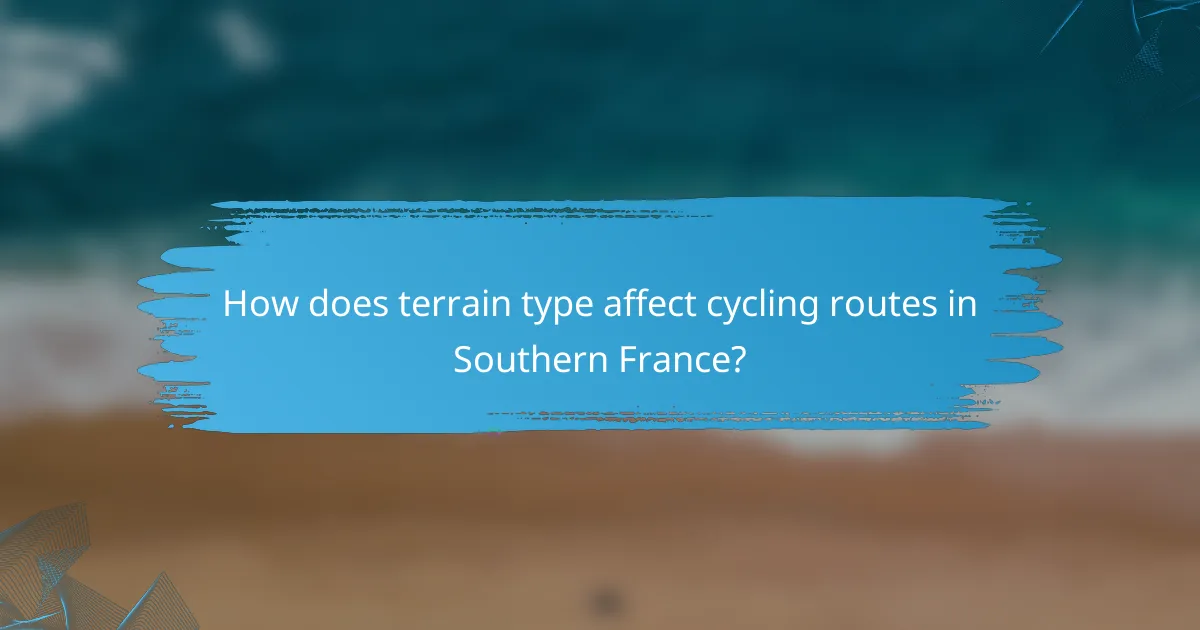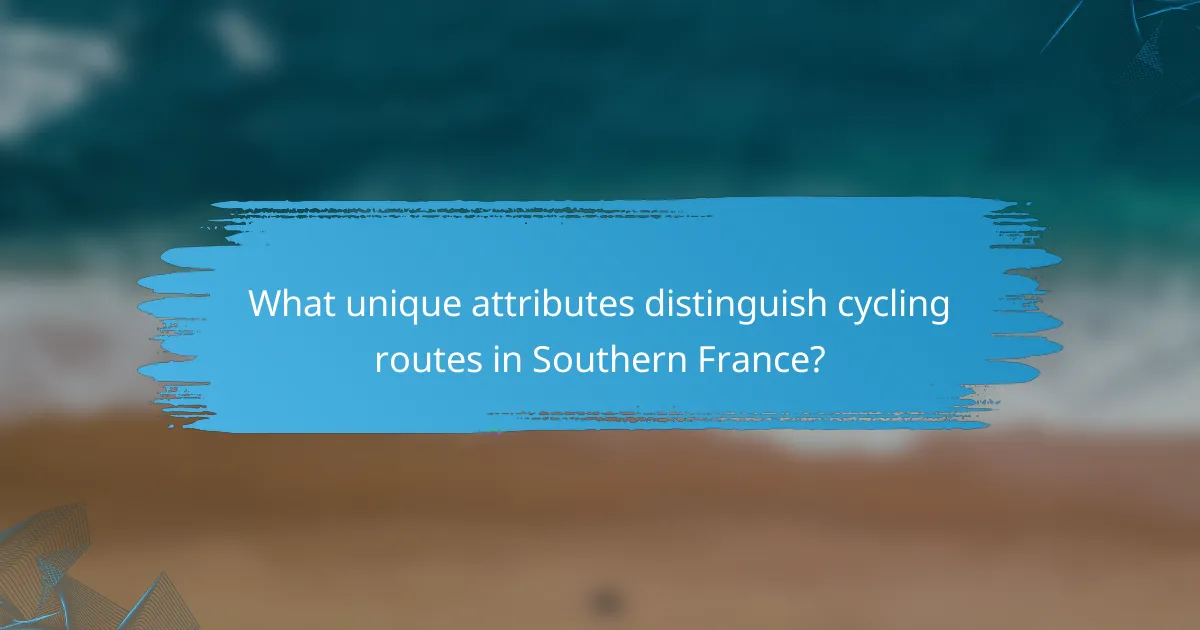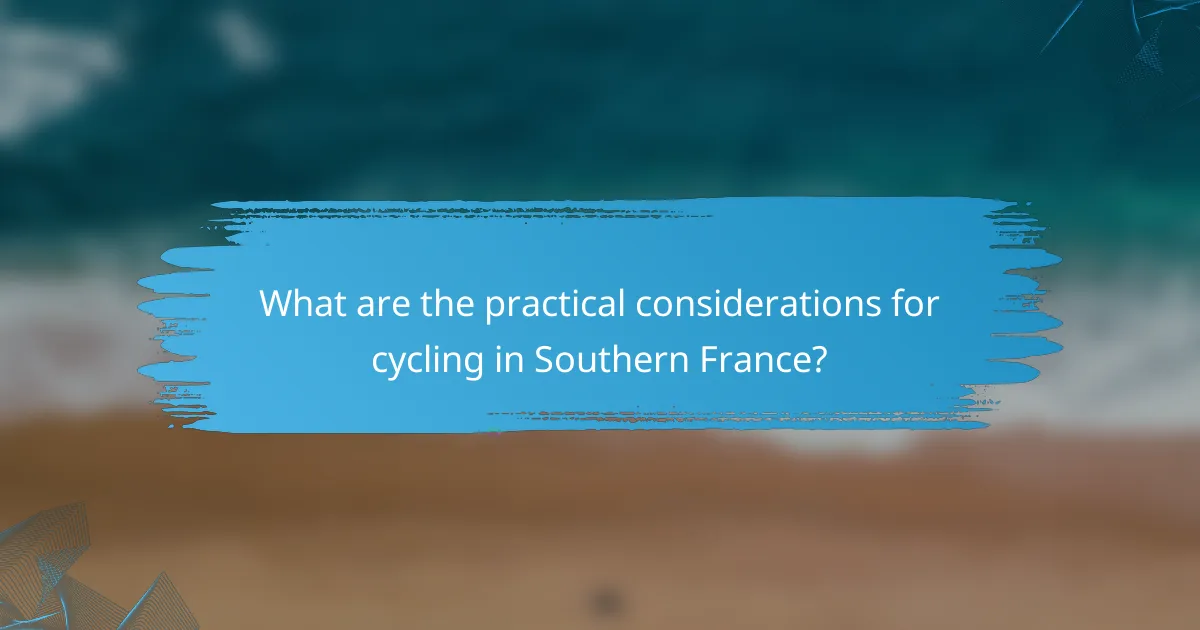Discover the best cycling routes in Southern France, featuring stunning scenic views, diverse terrain types, and rich local culture. Explore the picturesque Via Rhona, the serene Canal du Midi, and the challenging Mont Ventoux. Experience unique landscapes, from coastal paths to mountainous climbs, while engaging with local traditions and gastronomy. Plan your journey to enjoy an unforgettable cycling adventure in this beautiful region.

What are the most scenic cycling routes in Southern France?
The most scenic cycling routes in Southern France include the Via Rhona, the Canal du Midi, and the Mont Ventoux. These routes offer breathtaking views, diverse terrains, and rich local culture.
The Via Rhona stretches approximately 815 kilometers along the Rhône River, showcasing picturesque vineyards and charming villages. The Canal du Midi, a UNESCO World Heritage site, spans about 240 kilometers, featuring serene waterways and ancient trees. Mont Ventoux presents a challenging climb with stunning panoramas, attracting cyclists seeking adventure.
Each route highlights unique attributes of Southern France’s landscape and heritage, making them ideal for cycling enthusiasts.
Which routes offer the best views of the Mediterranean coastline?
The best views of the Mediterranean coastline can be found on the coastal cycling routes of Southern France. Notable routes include the Corniche d’Or, offering breathtaking cliffside panoramas, and the Via Aurelia, which features charming coastal villages. The Route des Crêtes provides stunning vistas of the Calanques National Park, while the coastal path from Nice to Menton showcases vibrant seaside scenery. Each route combines diverse terrain with local culture, enhancing the cycling experience along this picturesque coastline.
How do the vineyards influence the cycling experience?
Vineyards significantly enhance the cycling experience in Southern France by providing stunning landscapes, varied terrain, and a rich cultural backdrop. Cyclists can enjoy picturesque views of rolling hills and grapevines, which contribute to the scenic beauty of the routes. The terrain often includes gentle slopes and flat paths, making it accessible for different skill levels. Additionally, local vineyards offer opportunities for rest stops, wine tastings, and cultural immersion, enriching the overall journey. This combination of natural beauty and cultural experiences makes cycling through vineyards a unique adventure.
What are the historical landmarks along popular cycling paths?
Cycling routes in Southern France feature historical landmarks that enhance the scenic experience. Notable sites include the Roman aqueduct Pont du Gard, the medieval city of Carcassonne, and the Palace of the Popes in Avignon. Each location showcases unique architecture and rich cultural heritage. Cyclists can enjoy these landmarks while navigating diverse terrains, from gentle hills to flat riverbanks.

How does terrain type affect cycling routes in Southern France?
Terrain type significantly influences cycling routes in Southern France by affecting difficulty and scenic value. Varied landscapes, such as coastal paths, mountainous areas, and vineyards, offer unique cycling experiences. For instance, hilly terrain provides challenging climbs and rewarding views, while flat routes are ideal for leisurely rides. Additionally, terrain impacts local culture, as different regions showcase distinct architecture and gastronomy. Cyclists can explore diverse environments, from the Mediterranean coast to the Provence countryside, enhancing their overall experience.
What are the differences between coastal, mountainous, and rural terrains?
Coastal, mountainous, and rural terrains differ significantly in cycling experiences. Coastal routes offer scenic ocean views and flat pathways, ideal for leisurely rides. Mountainous terrains present challenging elevations and breathtaking landscapes, perfect for adventurous cyclists. Rural areas provide tranquil settings with rolling hills and less traffic, allowing for a peaceful ride.
Which terrain types are best suited for beginners versus advanced cyclists?
Beginners should choose flat, paved routes, while advanced cyclists can tackle hilly or mountainous terrains. Southern France offers a variety of cycling routes that cater to both skill levels.
Flat trails, such as those along the Canal du Midi, provide a smooth experience for novices. In contrast, advanced cyclists might enjoy the challenging ascents in the Alps or the Pyrenees, which feature steep gradients and varied surfaces.
Scenic views enhance the cycling experience, with beginners appreciating the ease of picturesque landscapes and advanced riders relishing the thrill of conquering difficult paths. Local culture can be explored along all routes, enriching the journey for cyclists of every level.
How do seasonal changes impact cycling conditions on various terrains?
Seasonal changes significantly affect cycling conditions in Southern France, impacting terrain types and scenic routes. In spring, mild weather enhances road conditions, while summer heat can lead to challenging climbs. Autumn offers vibrant foliage but may introduce wet trails, particularly in forested areas. Winter often results in snow on mountainous routes, limiting accessibility. Cyclists should consider these seasonal variations to optimize their cycling experience and enjoy the local culture.

What cultural experiences can cyclists encounter along the routes?
Cyclists can encounter diverse cultural experiences along the routes in Southern France. These include local festivals celebrating regional traditions, historical landmarks reflecting the area’s rich heritage, and markets showcasing artisanal products.
Interactions with local communities enhance the journey, allowing cyclists to enjoy traditional cuisine and learn about the customs of the region. Scenic views often feature vineyards and quaint villages, enriching the cultural immersion. The unique blend of landscapes and cultural elements creates a memorable cycling experience.
How do local festivals enhance the cycling experience?
Local festivals significantly enhance the cycling experience by offering cultural immersion and social interaction. They provide unique opportunities to explore local cuisine, arts, and traditions along cycling routes in Southern France. Festivals often feature scenic views and diverse terrain types, enriching the overall journey. Participating in these events creates memorable connections with the community and fellow cyclists, fostering a sense of belonging.
Which regional cuisines should cyclists try during their journey?
Cyclists should try the diverse regional cuisines of Southern France, including Provençal, Mediterranean, and Occitan dishes. Each region offers unique flavors and ingredients that enhance the cycling experience.
Provençal cuisine features fresh herbs, olive oil, and vegetables, with dishes like ratatouille and tapenade. Mediterranean influences include seafood and lighter fare, perfect for energy. Occitan dishes showcase hearty meals such as cassoulet, reflecting the local culture and traditions.
Sampling these cuisines not only fuels cyclists but also immerses them in the rich culinary heritage of the region. Enjoying local specialties enhances the overall journey, making it a memorable adventure.
What are the customs and etiquette for cyclists in Southern France?
Cyclists in Southern France should follow local customs and etiquette, including respecting traffic laws, signaling turns, and riding in single file on narrow roads. It’s important to greet fellow cyclists and pedestrians, and to be aware of local wildlife and terrain. Additionally, cyclists should wear helmets and bright clothing for safety.

What unique attributes distinguish cycling routes in Southern France?
Cycling routes in Southern France are distinguished by their diverse landscapes, cultural heritage, and varying difficulty levels. Unique attributes include the breathtaking coastal views along the Mediterranean, the challenging mountainous terrain of the Alps, and routes that pass through historic villages. Additionally, the local gastronomy and wine regions enhance the cycling experience, offering stops that showcase regional specialties. These elements create a rich tapestry of experiences for cyclists.
How do local cycling communities support riders?
Local cycling communities support riders by offering resources, camaraderie, and local knowledge. They organize group rides that foster social connections and enhance safety. Communities often provide maintenance workshops, teaching riders essential bike repair skills. Additionally, they advocate for improved cycling infrastructure, ensuring safer routes for all cyclists. Local events, such as races and festivals, celebrate cycling culture and encourage participation.
What role do guided tours play in exploring these routes?
Guided tours enhance the experience of cycling routes in Southern France by providing expert insights and local knowledge. They offer structured itineraries that showcase scenic views, diverse terrain, and cultural landmarks. Participants benefit from organized logistics, including bike rentals and accommodation, which simplify planning. Furthermore, guided tours often include opportunities for social interaction, fostering connections among cyclists. This immersive experience deepens appreciation for the region’s natural beauty and cultural richness.
Which hidden gems are often overlooked by tourists?
Cycling routes in Southern France often overlooked by tourists include the Vélodyssée, the Canal du Midi, and the Mont Ventoux area. These hidden gems offer stunning views, diverse terrain, and rich local culture.
The Vélodyssée stretches along the Atlantic coast, featuring scenic coastal paths and charming villages. The Canal du Midi provides a peaceful ride through vineyards and historical sites, making it ideal for leisurely exploration. Mont Ventoux offers challenging climbs and breathtaking panoramas, attracting cycling enthusiasts seeking adventure.
Exploring these routes reveals Southern France’s lesser-known beauty and cultural richness, providing a unique experience away from the tourist crowds.

What are the practical considerations for cycling in Southern France?
Cycling in Southern France requires careful planning for optimal enjoyment and safety. Key considerations include route selection, local weather conditions, and cultural engagement.
Scenic routes such as the Loire Valley and the Mediterranean coast offer breathtaking views. Terrain types vary from flat coastal paths to challenging mountain trails, suitable for different skill levels. Local culture enriches the experience, with opportunities to explore vineyards and historic towns along the way.
Weather can be unpredictable, so check forecasts before setting out. Hydration and sun protection are essential, especially during summer months. Familiarize yourself with local cycling laws and etiquette to ensure a respectful experience.
How should cyclists prepare for varying weather conditions?
Cyclists should check weather forecasts, dress in layers, and carry essential gear. Adapting to temperature changes ensures comfort and safety. For rain, waterproof clothing and lights enhance visibility. In hot weather, hydration and sun protection are crucial. Consider terrain types; steep climbs may be more challenging in adverse conditions.
What safety measures should be taken when cycling in rural areas?
To ensure safety while cycling in rural areas, cyclists should take several essential measures. Always wear a properly fitted helmet to protect against head injuries. Use bright or reflective clothing to enhance visibility, especially in low-light conditions. Equip your bicycle with lights and reflectors to ensure you are seen by motorists.
Plan your route ahead of time, choosing well-maintained roads and trails. Stay alert for potential hazards such as loose gravel, potholes, or wildlife. Carry a basic repair kit and know how to use it in case of a flat tire or mechanical issue. Lastly, inform someone of your route and expected return time for added safety.
Which gear is essential for a successful cycling trip?
Essential gear for a successful cycling trip includes a reliable bike, helmet, and appropriate clothing. Additional items such as a repair kit, water bottles, and navigation tools enhance the experience. A comfortable saddle is crucial for long rides, while padded shorts provide extra support. Proper footwear improves pedaling efficiency.
What are the best practices for planning a multi-day cycling journey?
To plan a successful multi-day cycling journey in Southern France, focus on route selection, preparation, and local culture.
1. Choose scenic routes that highlight the region’s natural beauty, such as the vineyards of Bordeaux or the lavender fields of Provence.
2. Assess terrain types to match your cycling skill level; hilly areas may require more stamina and preparation.
3. Plan daily distances to avoid fatigue, aiming for 40-70 kilometers per day depending on fitness.
4. Research local culture and attractions to enhance your experience; stop at markets and historical sites along the way.
5. Prepare for weather variations by checking forecasts and packing appropriate gear.
6. Ensure bike maintenance is up to date, including tire pressure and brake functionality, for safety and comfort.